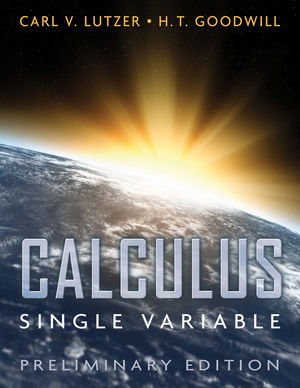
Calculus, Single Variable, Preliminary Edition
By Carl V. Lutzer, H. T. Goodwill
Lutzer and Goodwill’s Calculus 1e gives students a clear understanding of Calculus’ power and how it helps them succeed in future coursework and professions.
Through its conceptual, practical, and realistic approach to engineering, Calculus 1e develops a foundation for mathematical intuition. Rather than using isolated factoids, Lutzer/Goodwill helps students see the ‘whole picture’. This keeps students motivated to learn as they see the direct application of their studies in their future careers.
Schedule a Demo Sign Up for a Test Drive Adopt WileyPLUSWant to learn more about WileyPLUS? Click Here
Keeping students engaged
The discovery and subsequent study of calculus was originally motivated by the need to answer intriguing questions. We motivate the study of calculus by using intriguing questions from a myriad of disciplines to drive the narrative forward and pique students’ interest. At a fundamental level, we teach calculus in context, rather than in a vacuum.
Fostering mathematical literacy
Through demonstration and exercise, we teach students to read equations rather than “spell” them, so that equations are understood as a communication of ideas rather than as a collection of symbols to be manipulated. This goal, which is tightly connected the previous one, is partly achieved by using modern language that today’s SMECS students take for granted.
Developing both understanding and skills
Using a blend of both the traditional and reform emphases, our book helps students to develop intuition and broad comprehension as well as quantitative ability. In particular, it helps students develop a sense of what should be true and the ability to explain why mathematics is the way it is.
Facilitating the transition between disciplines
Calculus is used in a wide variety of disciplines, but students are often unable to transfer their knowledge and skills out of the calculus classroom. Through use of appropriate examples, dimensional analysis, and notation, our text prepares students to employ calculus when working on problems in their chosen disciplines.
Synthesizing content
We use the narrative and exercises to help students see calculus as a single, unified subject, rather than 50,000 little factoids. Relevant segues help the reader to build a conceptual picture of the calculus—understanding how each piece fits into, and contributes to the whole.
- Complete online version of the textbook included.
- Relevant, student study tools and learning resources to ensure positive learning outcomes, including:
- Algebra and Trigonometry Refreshers
- Additional Applets
- Immediate feedback to boost confidence and help students see a return on investment for each study session:
- 1200 algorithmic End-of-Section and End-of-Chapter homework questions
- 100 GO tutorial problems
- Content organized by Learning Objectives
- Pre-created activities to encourage learning outside of the classroom, including:
- Gradable Reading Assignment Questions (embedded with online text)
- Question Assignments: all end-of-chapter problems coded algorithmically with hints, links to text, whiteboard/show work feature and instructor-controlled problem solving help.
- Course Materials to help you personalize lessons and optimize your time, including:
- Lecture Note PowerPoint Presentations with Clicker Questions
- Instructor’s Solutions Manual
- Printed Test Bank
- Computerized Test Bank
Features Include

Carl Lutzer has been teaching collegiate level mathematics since 1993. He earned his Ph.D. from the University of Kentucky, where he was a finalist for the Chancellor’s Award for Excellence in Teaching in 1997 and a recipient of the award in 1998. He moved to Rochester in 2000 and joined the faculty of RIT, where he is currently a professor of mathematics in RIT’s School of Mathematical Sciences. He was a 2000-2001 ExxonMobil Project NExT Fellow and was a finalist for RIT’s Eisenhart Award for Excellence in Teaching in 2002, 2003, and 2007. He has published several pedagogical articles that provide teachers with better ways of teaching calculus, linear algebra, and ordinary differential equations—one of which was awarded the MAA’s Carl B. Allendoerfer Award (2007). He has also written articles about inverse problems in pseudodifferential operator theory, micro-electro-mechanical systems, Cantor disks, and protein mixtures in the human eye. In addition to mathematics and teaching, he enjoys writing fiction, fencing (sabres, not chain-link), and playing with his kids.

Tim Goodwill started teaching professionally at the age of 18 when he taught computer science classes to elementary school and high school students. During the course of his professional career, he has taught a wide variety of subjects including music, religion, Shaolin kung-fu, fencing, and genealogy. He earned his M.A. in mathematics from the University of Kentucky, where he and Dr. Lutzer developed both a friendship and a literary relationship—their first novel, The Dark Cloak of Night, is finished and ready for publication. Tim is currently a lecturer in the School of Mathematical Sciences at the Rochester Institute of Technology, where he has been nominated for RIT’s Eisenhart Award for Excellence in Teaching every year since joining the faculty. His professional interests focus on students who lack confidence or struggle mathematically, and on the use of technology in teaching. This year, he has developed a series of computer animated tutorials for distance learning students in calculus and differential equations. In his spare time, he meets Dr. Lutzer on the fencing strip, plays piano, practices aikido, and spends time with his family.
Chapter 1. TOOLS OF THE TRADE
1.1. Power Functions
1.2. Polynomials
1.3. Rational Functions
1.4. Algebraic, Composite, and Piecewise Functions
1.5. Periodic Functions & Transformations
1.6. Exponential Functions
1.7. Logarithms
1.8. Inverse Functions
- Chapter Review
- Projects & Applications – Richardson’s Arms Race
Chapter 2. LIMITS AND CONTINUITY
2.1. Introduction to Limits
2.2. Calculating Limits
2.3. Limits at Infinity
2.4. The Technical Definition of a Limit
2.5. Continuity
- Chapter Review
- Projects & Applications – The Apothem and Limits at Infinity; Implementing the Bisection Algorithm
Chapter 3. THE DERIVATIVE
3.1. The Derivative
3.2. Derivatives of Power Functions
3.3. Derivatives of Trigonometric and Exponential Functions
3.4. The Derivative as a Function
3.5. The Product Rule & Quotient Rule
3.6. The Chain Rule
3.7. Derivatives of Inverse Functions
3.8. Implicit and Logarithmic Differentiation
- Chapter Review
- Projects & Applications – Parabolic Reflectors; The Cumulative Area Function
Chapter 4. APPLICATIONS OF THE DERIVATIVE
4.1. Linear Approximation
4.2. Related Rates
4.3. Higher Order Derivatives
4.4. Local and Global Extrema
4.5. Mean Value Theorem & L’Hopital’s Rule
4.6. Curve Sketching
4.7. Optimization
- Chapter Review
- Projects & Applications – Implementing Newton’s Method; Optimization and Apothem; Energy and Force; Quantum Mechanics
Chapter 5. INTEGRATION
5.1. Estimating Net Change
5.2. Area and the Definite Integral
5.3. Numerical Methods of Integration
5.4. Antiderivatives & the Fundamental Threorem
5.5. More About the Fundamental Theorem
- Chapter Review
- Projects & Applications – Numerical Integration with Spreadsheets; An Introduction to Stirling’s Approximation; Pollution and Pulmonary Distress
Chapter 6. TECHNIQUES OF INTEGRATION
6.1. Substitution
6.2. Integration by Parts
6.3. Overview of Trigonometric Integrals
6.4. Trigonometric Substitution
6.5. Partial Fractions Decomposition
6.6. Improper Integrals
- Chapter Review
- Projects & Applications – The Gamma Function; The Seasons
Chapter 7. APPLICATIONS OF INTEGRATION
7.1. Arc Length & Surface Area
7.2. Solids of Revolution & the Method of Slicing
7.3. Volumes by Cylindrical Shells
7.4. Work, Energy, and Force
7.5. Center of Mass and Radius of Gyration
7.6. Hydrostatic Force
7.7. Average Value
7.8. Probability
- Chapter Review
- Projects & Applications – Ideal Gas, Energy, and the n-Dimensional Ball; Asteroid Mining; Stopping on a Dime
Chapter 8. SEQUENCES & SERIES
8.1. Sequences
8.2. Introduction to Series
8.3. Integral Test and Estimating Sums
8.4. Comparison Tests
8.5. Absolute Convergence, Ratio & Root Tests
8.6. Introduction to Power Series
8.7. Elementary Operations with Power Series
8.8. Taylor & Maclaurin Series
8.9. Applications of Taylor Series
- Chapter Review
- Projects & Applications – Revisiting Stirling’s Approximation; Weighing Exploitation Against Retaliation
Chapter 9. PARAMETRIC CURVES, POLAR COORDINATES, AND COMPLEX NUMBERS
9.1. Parametric Curves
9.2. Calculus with Parametric Curves
9.3. Polar Coordinates
9.4. Calculus in Polar Coordinates
9.5. Introduction to Complex Numbers
- Chapter Review
- Projects & Applications – Planetary Orbits
Chapter 10. DIFFERENTIAL EQUATIONS
10.1. Introduction to Differential Equations
10.2. Autonomous Equations and Equilibria
10.3. Slope Fields and Euler’s Method
10.4. Separable Equations
10.5. Linear Equations
10.6. Introduction to Dynamical Systems
- Chapter Review
- Projects & Applications – Crosswind Landing; Pursuit Curve 835
Appendix A Trigonometry
Appendix B Review of Algebraic Techniques
Appendix C Binomial Coefficients
Appendix D Conic Sections
Appendix E The World We Live In
Appendix F End Notes 890
Bibliography 895

